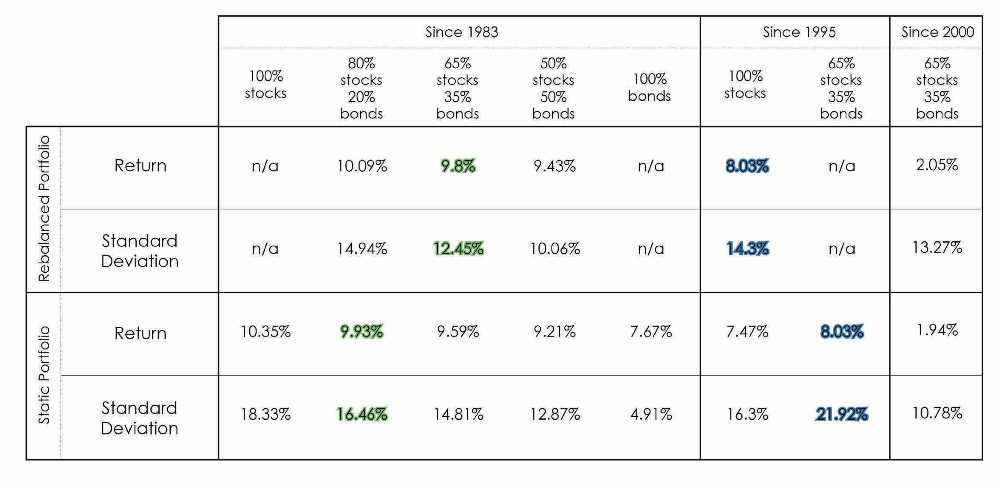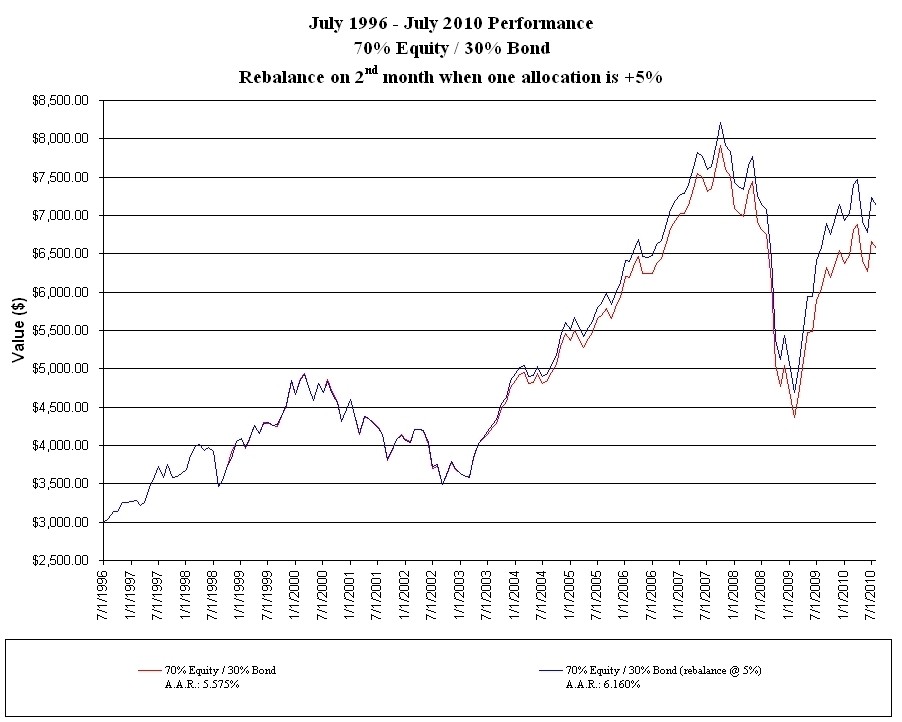What is the Best Portfolio Rebalancing Strategy
Post on: 3 Июнь, 2015 No Comment

In this Ask The Expert With Larry Swedroe article, the reader (Edward) is wondering whats the best way to rebalance his investment portfolio and increase his fixed asset allocation. Due to the stock market crash. he is reluctant to sell his beaten down stocks to increase his bonds allocation. Is it better just to allocate new money toward bonds? What should he do? Heres the question from Edward:
Im 52 year old, have a stable job, my house and vehicle are paid, and no child expenses. Im able to invest $60k per year. My current asset allocation is somewhat aggressive: 78% equities (58% U.S. and 20% foreign), 16% bonds, 6% cash. I want to start reducing my equities as a percentage of the total. Given the current market environment, Im thinking it isnt wise to sell equities to reach that allocation. Instead, Im thinking it would be best to do so more slowly through significantly tilting my future contributions toward bonds (e.g. 70% bonds and 30% equities). Does my strategy make sense or should I sell equities now to do so? Also, in your opinion is my asset allocation way off? I plan on working until 66.
Answer from Larry Swedroe
Edward, first let me say that there is no right asset allocation. Second, a major error that many investors make is to consider just their age in determining their asset allocation. There are other factors including the correlation of your earned income (labor capital) to the risks of equities. In your case it sounds as if it is low so all else equal you can take more equity risk than say a car salesman or construction worker.
My book, The Only Guide to a Winning Investment Strategy Youll Ever Need . provides you with three tables on the ability, willingness and need to take risk, to help you identify the right allocation for you.
- The ability depends on your time horizon (Not until retirement, but life expectancy, plus some extra time because half of the people will live longer) and stability of earned income.
- The willingness is what I call the stomach acid test: how well you can stand the pressure that bear markets bring without losing sleep or panicking and selling.
- The need to take risk is the rate of return you need to achieve your financial objectives the higher the rate the more equity risk you hold.

Unfortunately, I dont have enough information to provide the right answer. Before we design an asset allocation for a client we spent many hours doing what we call a discovery process so that we can learn what is important about money to each person and help answer the questions on ability, willingness and need to take risk.
Another point is that the equity allocation alone is not enough. For example, the more small and value and emerging market stocks you own, the less equity risk you need to achieve your goal (because they have higher expected returns than the market in general). For example, we estimate that our model portfolio we call Risk Target 3 (we have several different models we use as starting points for discussions with clients based on their unique situations) with a very high allocation to small and value stocks has an expected return that is about 3% above the expected return of the market. Our Risk Targets 1 and 2, with lower exposures to those riskier stocks, have expected returns that are about 1 and 2% above the market. So an investor choosing Risk Target 3 can have a lower equity allocation than an investor choosing Risk Target 1 or 2. So I would need to know what funds you own and what their exposures are to these risk factors. And also a lot more to give proper/informed advice. Unfortunately, far too many people including investment advisors give cookie cutter answers instead of tailoring the answer to the individual, unique situation.
As to your question about acting now or slowly moving to the right allocation. My answer is always the same to these type questions. Absent the issue of transactions costs and taxes that might be incurred, your current holdings are irrelevant. The right answer is to figure out what your allocation should be and then get there immediately. Think of it this way: If you had no holdings other than cash, how would you allocate? Then do it immediately.
If taxes are involved, then you should consider them, but dont let them dominate the decision. Too many people have lost huge amounts because they let taxes dominate the decision. One of my favorite expressions is that the only thing worse than paying taxes is not having to pay them. Finally, as you approach the withdrawal phase (when your ability to take risk falls significantly) you should begin to lower your equity exposure. So that might be one solution as you suggested. But if your equity holdings now exceed your need to take risk (or willingness) you should sell now, regardless of what you think the market might do. The reason is that you cannot control outcomes (the market can go a lot lower). The only thing you can control are costs and risks. And you should not take more risk than you need to take.
So spend a little time educating yourself about the ability, willingness and need to take risk and then write an Investment Policy Statement and sign it. And note that one of my favorite expressions is education may (or may not) be expensive, but ignorance can cost you dearly. While no rational person would take a trip to a place they had never been without a road map and directions, far too many investors do not have an investment road map (that IPS).
Disclaimer: Mr. Swedroes opinions and comments expressed are his own, and may not accurately reflect those of the firm, nor Moolanomy and its owner.














